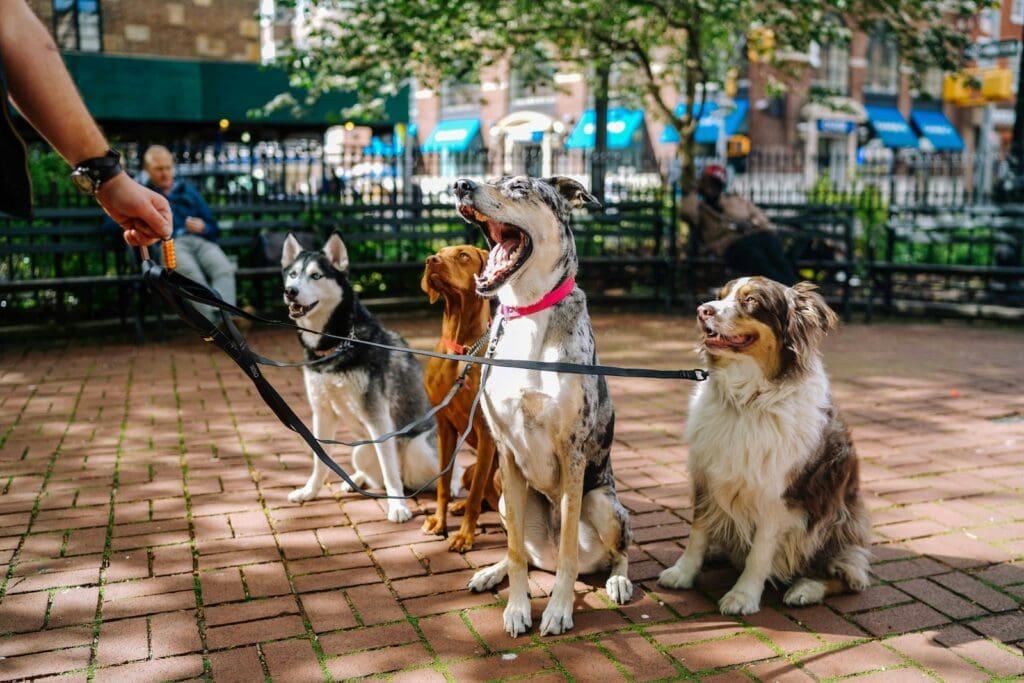
In the rapidly evolving digital marketplace, choosing the right top-level domain (TLD) can significantly impact a pet-related business’s online presence. The introduction of niche TLDs, such as .dog, offers unique opportunities for brand identity reinforcement and targeted marketing. Specifically tailored to the pet industry, a .dog domain is not only memorable but also instantly communicates the business’s relevance to pet owners, dog enthusiasts, and related services.
A .dog TLD can bolster search engine optimization (SEO) efforts, making it easier for potential customers to discover a business organically. With its distinct and industry-specific nature, a .dog domain enhances a pet business’s visibility in search results, connecting the brand with a specific audience seeking pet-related products or services. The direct association with the pet industry can help businesses to stand out in an overcrowded online space, establishing a clear and memorable digital identity.
Key Takeaways
- A .dog domain directly indicates a business’s relevance to the pet industry.
- Such TLDs can improve a business’s SEO and online visibility.
- Memorable domains contribute to effective and niche-targeted marketing.
Understanding the .Dog Domain
When considering a top-level domain (TLD) for pet-related businesses, the .dog domain stands out for its specificity and industry relevance.
The Basics of TLDs and .Dog
Top-level domains (TLDs) are the final segment of a domain name, following the final dot. They classify domains by purpose or geographical area. The .dog domain extension is a specialized TLD intended for those in the dog-related industry. It offers an instant association with pet services and products, signaling to customers the primary focus of the business.
.Dog Vs. Traditional Domains
The .dog TLD diverges from traditional domains like .com or .net that are oversaturated and lack industry specificity. Businesses that choose a .dog domain can benefit from enhanced brand identity and improved SEO due to the relevant keyword directly in the domain name. This relevance can make the domain more memorable to consumers and may improve search engine rankings for dog-related queries.
Registration Process for a .Dog Domain
To register a .dog domain, businesses must go through an ICANN-accredited registrar. The process involves checking the domain’s availability and then proceeding through the standard registration procedure, which may include providing contact information and specifying registration duration. Requirements may vary slightly among registrars, but there typically aren’t restrictive prerequisites to secure a .dog TLD. It’s an accessible choice for any entity, ranging from dog breeders to pet supply stores, looking to carve out a niche in the online pet industry space.
Advantages of a .Dog Domain for Pet Businesses
The selection of a .dog domain extension offers pet businesses specific advantages in brand identity, search engine optimization, and marketing efforts. These benefits are tailored to align closely with the needs of companies specializing in dog-related products and services.
Brand Identity and .Dog
A .dog domain immediately signifies the niche that a business operates within, signaling to consumers that the brand specializes in canine-related offerings. Brand identity is sharply reinforced through a distinctive TLD that distinguishes pet businesses from the competition. It helps create a cohesive and focused brand image, which customers associate with dog-related products, solidifying the company’s place in the pet industry.
SEO Benefits of .Dog Domain
From an SEO perspective, a .dog TLD is advantageous for businesses targeting dog owners. Search engines often reward domain names that match common search queries. When users search for dog-specific products or services, a .dog domain may rank higher due to its relevance. Additionally, businesses benefit from increased click-through rates from search engine result pages, as potential customers are more likely to click on a domain that clearly matches their search intent.
Marketing and Memorability
For marketing strategies, a .dog domain is inherently memorable and catchy, making it a powerful tool for branding efforts. Customers are more likely to remember a concise and direct domain, which is critical for word-of-mouth marketing and return visits. In advertising, a .dog domain can be a versatile asset, allowing for creative campaigns that resonate with dog enthusiasts and reinforce the brand’s focus on this specific audience segment.
Building a Community with a .Dog Domain
A .dog TLD naturally garners attention from canine enthusiasts and serves as a focal point for services and organizations dedicated to dogs.
Fostering Canine Enthusiast Networks
Community Creation: A .dog domain offers a unique opportunity for creating an online hub for dog lovers. By choosing this TLD, businesses directly appeal to a targeted demographic of canine enthusiasts. This direct connection fosters a tight-knit community centered around shared interests in dog breeds, care, and culture.
- Network Engagement: Online forums, social media integration, and member-exclusive content on a .dog website encourage active participation and sustained engagement within the community.
Supporting Dog-Related Services and Organizations
Strategic Alliances: Pet businesses benefit from a .dog domain by aligning with dog-related services like trainers and veterinarians, and organizations such as shelters and breeding clubs. A specialized TLD curates a sense of solidarity and support among different entities that cater to canine needs.
- Resource Hub: A .dog site can become a go-to resource for pet owners seeking various services, from training tips from certified trainers to medical advice from professional veterinarians.
- Breeder and Shelter Support: Breeders and shelters can utilize a .dog domain to showcase their commitment to ethical breeding practices and animal welfare, establishing trust and credibility within the community.

Customization and Relevant Web Addressing
Selecting a .dog domain offers distinct customization options that can effectively categorize a business within the pet industry, streamline their web presence, and solidify their niche in email communication. These domain choices allow companies to instinctively convey their speciality to consumers with just a glance.
Categorization and the .Dog Extension
The .dog TLD acts as a clear signal, categorizing a website in the pet sector immediately. This categorization allows pet businesses to reinforce their brand identity as dog-centric in both the mind of customers and within search engines. Search Engine Optimization (SEO) benefits from this categorization by potentially improving visibility for dog-related search queries. Moreover, a .dog domain leaves a memorable imprint, helping consumers remember the web address easily when they are seeking pet-related services or products.
Creating Specific Email Addresses
Customization extends to email addresses, allowing businesses to create specific points of contact that resonate with their brand. For example, service@pawsandtales.dog not only reinforces the company’s focus but also provides a level of professionalism that generalized domain names might lack. Such specificity aids in marketing strategies by crafting a consistent brand message across all platforms and communications. Email correspondence becomes an extension of the brand, supporting a unified and comprehensive brand experience.
Technical Aspects of .Dog Domains
Choosing a .dog domain entails understanding its technical aspects, which ensure the website is secure, reliable, and effectively managed.
Understanding DNS for .Dog Domains
The Domain Name System (DNS) is critical for any TLD, including .dog domains. It translates domain names into IP addresses, allowing browsers to load the resources of a pet business’s website. A .dog domain must be registered with a DNS that effectively directs customers to the correct website, ensuring no confusion in the vast sea of internet addresses.
Security Features for .Dog Domains
Security is paramount for .dog domains, similar to any other TLD. Implementing SSL certificates is a standard practice that encrypts data transferred between the user and the website, which is particularly important for pet businesses to protect customer data. Additionally, many .dog domain registrars support DNSSEC (Domain Name System Security Extensions), which adds an extra layer of security by preventing attackers from corrupting the DNS data and guiding users to fraudulent websites.
Transfer Protocols and .Dog Domain Management
For a .dog domain, transfer protocols are essential for domain management and ensuring seamless domain transfers between owners or registrars. The process includes authorization codes and a transfer request to the gaining registrar, which must be easy to navigate for effective management. The ability to transfer domains with minimal disruption is vital for business owners who may need to change service providers while maintaining their online presence.
Enhancing Business Services with .Dog Domains
Choosing a .dog domain clearly communicates what a pet business offers. This specificity is not only beneficial for search engine optimization (SEO) but also streamlines customer access to services like grooming, training, and daycare.
Innovations in Dog Grooming and Training Services
.Dog domains offer a unique opportunity for grooming and training services to stand out in the digital space. For instance, a domain such as SnipAndClip.dog immediately informs potential clients that the business focuses on dog grooming. Integrating this TLD can also enhance online booking systems, allowing customers to seamlessly schedule appointments.
Businesses can leverage this digital brand identity to highlight specialized training methods. A .dog domain like PawsitiveTraining.dog can be developed to showcase innovative training programs, thereby attracting dog owners who seek modern and effective training for their pets.
Integrating .Dog with Doggy Daycare and Pet Stores
For doggy daycare centers, a .dog TLD reinforces the specificity of service. Domains such as HappyPawsDaycare.dog instantly communicate their target clientele: dogs and dog owners. These centers can link their .dog websites to live webcams, allowing owners to check in on their pets and reinforcing trust and transparency.
Pet stores gain an edge by incorporating .dog domains too. A straightforward domain like PetSupplies.dog promises a focused shopping experience for dog-related products. Online platforms with a .dog TLD can feature smart categorizations of goods, from Nutrition to Toys, streamlining the customer’s purchasing journey.
Comparative Assessment of .Dog Domain Costs
When considering a .dog domain, cost is a crucial factor for pet-related businesses. This assessment will provide a detailed examination of .dog domain pricing and how it stacks up against traditional TLDs like .com, focusing on value for money and additional fees.
Evaluating .Dog Domain Prices
The price range for a .dog domain can vary significantly between registrars, with costs generally starting from approximately $20 to $40 annually. Businesses should note that prices can fluctuate based on additional features such as privacy protection or email services. It’s also important to consider the ICANN fee, which is a nominal charge included in the purchase of any domain. This fee is generally under $1.00, but it’s a uniform cost that affects all TLD registrations.
Comparing .Dog with .Com and Other TLDs in Terms of Value
.Com domains are traditionally the most recognized TLDs, often seen as default choices for businesses. However, a .com can be significantly more expensive, especially for short and memorable domain names, sometimes costing thousands of dollars. In contrast, a .dog domain not only typically offers a lower entry price but also provides direct relevance and branding for pet businesses, enhancing SEO benefits and marketing strategies.
Comparing a .dog domain to other niche TLDs, the .dog often holds a competitive edge in terms of brand identity reinforcement specific to the pet industry. Pet-related businesses gain a memorable TLD that conveys their market focus instantly, potentially offering better value when aligning with marketing goals compared to more generic TLDs.
Targeting Niche Markets with a .Dog Domain
Choosing a .dog TLD allows pet businesses to directly appeal to their core audience, standing out within niche markets.
Specialized Markets: Assistance Dogs and Pet Adoption
Assistance Dogs: A .dog domain signals a specialized commitment, drawing in customers seeking services and products specifically for assistance dogs. Websites like Service.dog or Therapy.dog offer immediate clarity, showcasing dedication to the sector and enhancing search visibility among users looking for assistance dog-related information.
Pet Adoption: Utilizing a .dog domain, like Adopt.dog, can set pet adoption agencies apart, conveying a direct-to-consumer approach. It enables them to target individuals looking to adopt, offering a streamlined interface that reflects their specialty in dog adoptions, potentially increasing their website traffic and adoption rates.
Expanding to Dog Food Suppliers and Veterinarians
Dog Food Suppliers: For businesses specializing in canine nutrition, a .dog domain reinforces the brand’s focus. A domain like Healthy.dog aims directly at the high-quality dog food market, making it more discoverable for consumers intent on finding premium dog fare.
Veterinarians: A .dog TLD can assist veterinarians in highlighting their services for dog owners. Domains such as Vet.dog or Care.dog embody a brand identity that resonates with dog owners’, emphasizing the commitment to canine health and potentially improving search engine rankings within this specific market.
.Dog Domains and International Considerations
When embarking on the journey of securing a .dog domain, businesses must navigate a landscape influenced by global registration processes and varying fiscal policies. The adept selection of a .dog TLD involves understanding the international terrain and complying with local regulations.
Navigating .Dog Domain Registration Globally
Securing a .dog domain on a global scale requires awareness of the specific registration requirements that may differ by country. For instance, while a UK-based business may not face significant hurdles when registering a .dog domain, entities in other countries could encounter particular nuances in the process. It is essential to investigate whether a physical presence or business registration within a country, for example, the .br (Brazil) domain, is necessary before acquisition.
Key points for global registration include:
- Local presence requirements: Some countries might mandate local contact information or legal business registration.
- Administrative contact: Having a reliable individual or entity within the country to facilitate communications can be advantageous.
The Impacts of VAT and Local Regulations on .Dog Domains
Financial considerations, such as value-added tax (VAT) and local regulations, can significantly impact the cost and maintenance of a .dog domain. VAT rates, which can vary considerably from one country to another, should be factored into the budget for the domain. For example, the VAT implications for a .uk domain will differ from those of another regional domain. Additionally, businesses must comply with local regulations that govern the use and ownership of internet domains.
Considerations for VAT and regulations:
- VAT rates: Understand how the VAT in a given region affects the total cost of acquiring and renewing the domain.
- Compliance with legal frameworks: Businesses must ensure their domain usage aligns with both international standards and local internet governance policies.

